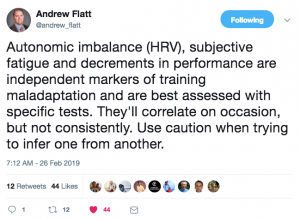A recent article on the Uphill Athlete site highlighted difficulties that mountain sports coaches had had when trying to identify chronic (i.e. longer lasting) fatigue using HRV in some of their athletes. They graciously gave us the opportunity to reply, which is now is part of the revised article.
In addition, here is a short summary of key points to bear in mind when using heart rate variability (HRV) to detect overreaching is:
- Athletes with a low resting heart rate (below 50 bpm) must take HRV tests in the standing position to avoid parasympathetic saturation.
- Watch for trends in the baseline – trends in this and reductions in day-to-day variability can be important signs of impending non-functional overreaching NFOR (More on that here).
- Take the result of the first reading in the morning, and don’t try to second guess the software by taking multiple readings. Rising anxiety will distort, and usually lower the reading – this is also why we don’t recommend doing readings on race day!
- In order to be absolutely sure that overreaching is occurring, we strongly recommend taking the athlete’s subjective wellness scores (especially fatigue and mood) into account as well as trends in HRV. The Simon Says AI in ithlete Pro uses these, as well as the promising Acute : Chronic training load ratio to give advice. Note that the Simon Says AI was not used by the athletes in the Uphill Athlete article.
Dr Andrew Flatt, pioneer of HRV testing and research in elite team and individual sports recently sent out this tweet encouraging the use of multiple metrics, incl HRV and subjectives to make confident diagnosis of potentially non-functional overreaching (NFOR):

HRV is the most precise window into the nervous system available. However, the human body is a complex system, and increasingly under stress from multiple sources at the same time. So it makes sense to take all available data into account to complete the picture.
To get from 90-95% accuracy to 100% requires assessment of Training Load, and subjective wellness factors, all of which ithlete provides, and brought together by ithlete Pro.

Following my own observations DFA2 is the perfect indicator for measuring fatigue. It drops after training and the optimum is 1 during runs. Can’t find any information around it on the internet…
Hi Luuk. Thanks, That’s an interesting comment that prompted me to look into it more. I did a search for ‘HRV DFA2’ and found a few good references, one of which is on extreme endurance exercise https://physoc.onlinelibrary.wiley.com/doi/pdf/10.14814/phy2.13905 and seems to confirm what you are saying. One of the authors is a collaborator of ours – I will try to ask him about it next time we meet. If you have any data you’d like to share, feel free to contact me! Best, Simon at myithlete.com